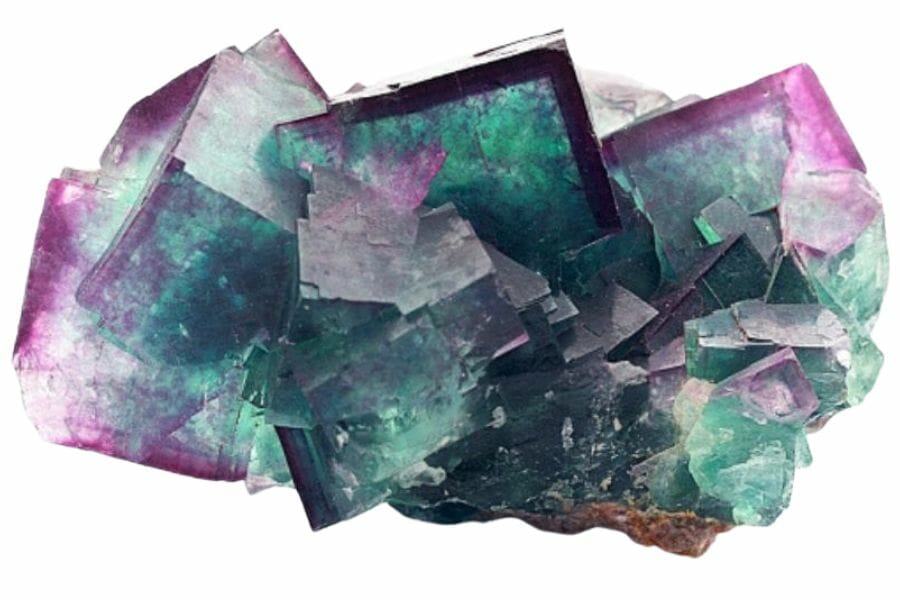Finding crystals can be a rewarding adventure, offering a unique way to explore the natural beauty and geology of the region. Whether you’re a seasoned rockhound or just getting started, knowing where to look is key to uncovering these hidden treasures.
In this state, a variety of locations provide opportunities to discover different types of crystals. From rocky outcrops in the mountains to stream beds that carry sparkling surprises, each area offers its own unique finds for those willing to search.
We can help you get started with some places you can explore for crystals below!
Crystals you can find in the US
The United States offers a wide range of crystals that reflect its diverse geology. From vibrant gems to more subtle mineral formations, there’s something to discover in nearly every region.
Calcite

With a variety of forms and a unique property of double refraction, calcite allows objects viewed through the crystal to appear doubled. This mineral can appear in a spectrum of colors, with pure forms typically being transparent or white.
In addition, calcite reacts vigorously with acids, which aids in distinguishing it from other minerals. It also frequently contributes to the structure of sedimentary rocks such as limestone.
Gypsum

Gypsum’s notable softness allows it to be easily scratched with just a fingernail, often presenting as white or very light-colored in its pure form.
It manifests in both crystalline forms, like selenite, and massive forms such as alabaster, making it versatile in use and appearance.
Gypsum is also essential in the construction industry and is a key component in the manufacture of plaster and drywall.
Fluorite

Fluorite comes in a wide range of vibrant colors, including purples, greens, blues, and yellows, and is known for forming in well-defined cubic crystals.
Beyond this, fluorite exhibits fluorescence under ultraviolet light! It can also be used in various industrial applications, including as a flux in steelmaking.
Galena

Galena distinguishes itself with a metallic luster and high density, typically found in a cube-like form. It serves as the primary ore of lead, making it important in the metal industry, while its shiny, silver color attracts collectors.
Not only does its appearance make it a subject of interest, but its weight and texture provide tangible lessons in mineral density and metallic properties. Galena also often contains traces of silver, adding to its commercial and educational value.
Corundum

Corundum is a mineral that comes in a variety of colors, though it is typically transparent or gray. Its most famous forms are sapphires and rubies, which are prized for their vibrant blue and red hues.
The mineral is known for its remarkable hardness, ranking just below diamond on the Mohs scale. This durability makes corundum ideal for industrial abrasives and cutting tools, as well as a popular choice for fine jewelry.
Quartz
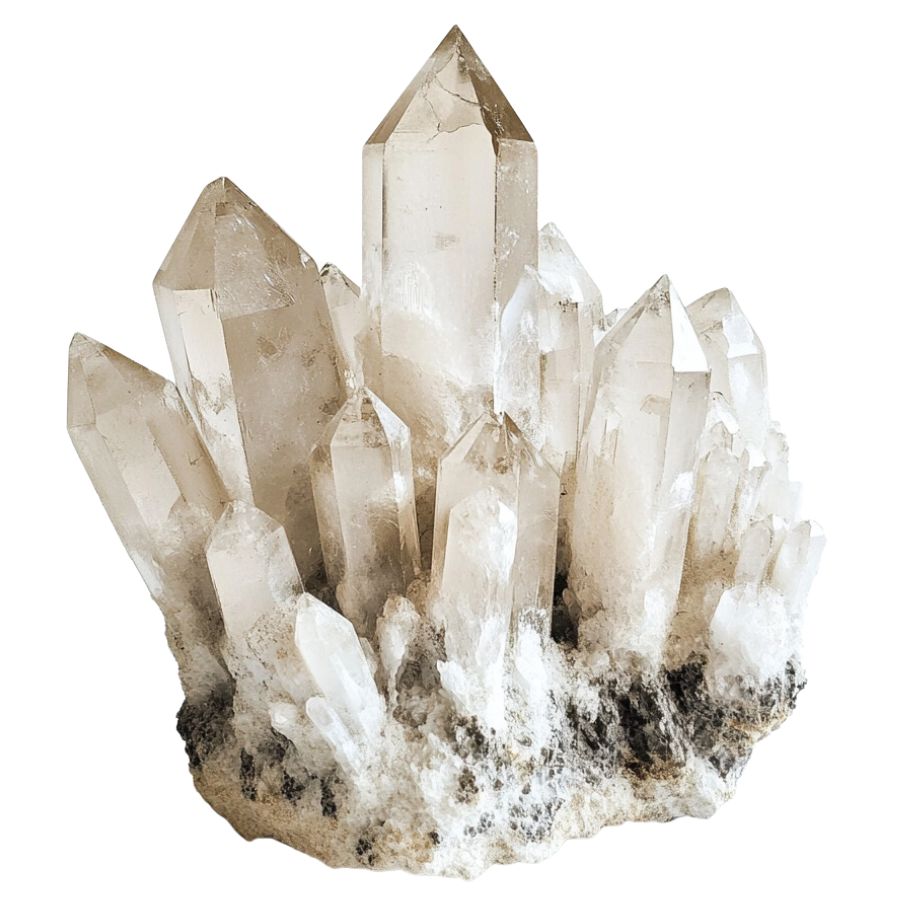
Quartz is among the most common minerals in the Earth’s crust and is prized for its durability and variety. It forms in a wide range of colors and types, from clear rock crystal to purple amethyst.
The mineral is notable for its hardness and durability, which contribute to its use in a variety of applications. Quartz is also popular in the manufacturing of electronics and watches due to its piezoelectric properties, which allow it to convert mechanical pressure into electrical energy.
Pyrite

Often mistaken for gold due to its metallic luster and pale brass-yellow hue, pyrite is known colloquially as “fool’s gold.” Its characteristic cube-shaped crystal formations look man-made but are actually completely naturally formed!
Pyrite also has historical importance in producing sulfur dioxide for sulfuric acid production.
Rhodochrosite
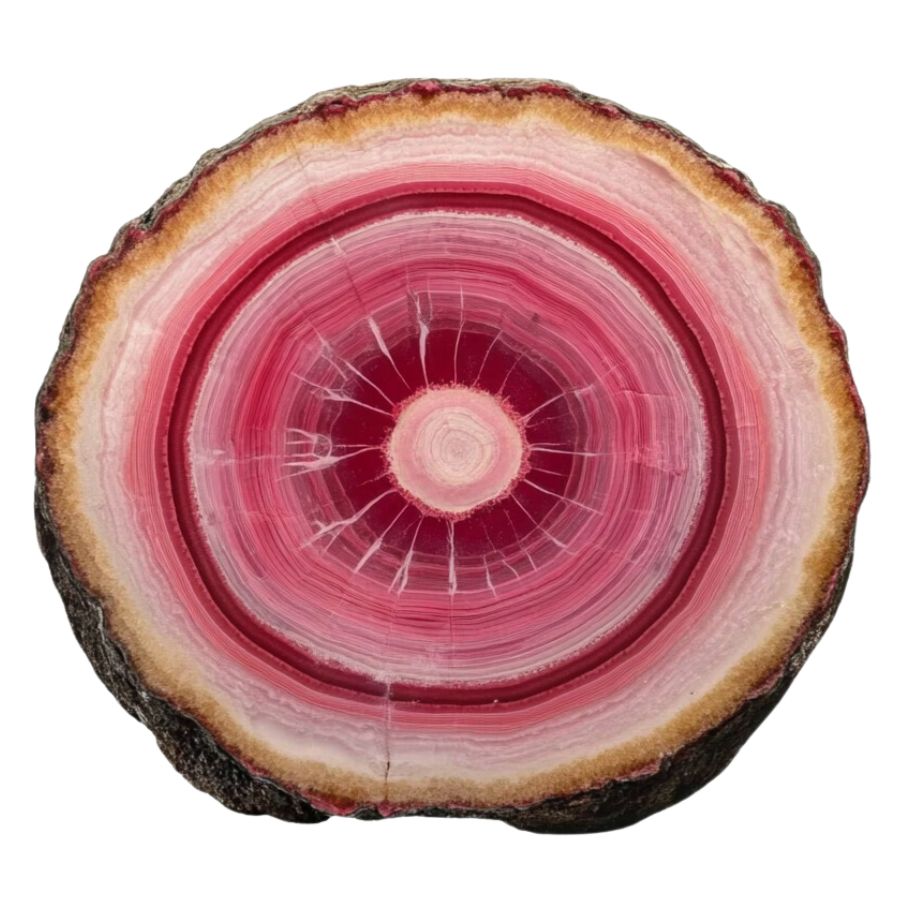
Rhodochrosite stands out with its rich pink and red hues, making it highly desirable as both a mineral specimen and a gemstone.
It typically forms in layered or stalactitic structures, with bands of colors that showcase how it grew over millions of years.
Beyond its beauty, rhodochrosite is significant as the main source of manganese, an essential element used in metal alloys.
Rhodonite

Appreciated for its deep pinks and reds, often complemented by black manganese oxide veins, rhodonite presents a dramatic appearance. It is typically found in metamorphic rocks and is used both as an ornamental stone and in jewelry.
In geology, rhodonite is significant for its role in metamorphic processes and its association with other manganese-rich minerals. It can be found in metamorphosed sedimentary rocks and is sometimes used as an indicator of the presence of manganese deposits.
Vivianite

Vivianite, an iron phosphate mineral, emerges in low-oxygen environments like peat bogs or iron-rich deposits. Its striking blue to green color, which can change to a lighter shade over time due to oxidation, makes it a distinctive mineral.
Found in various geological settings, vivianite provides clues about the local conditions and the presence of phosphate deposits.
The Types of New York Crystals You Can Find
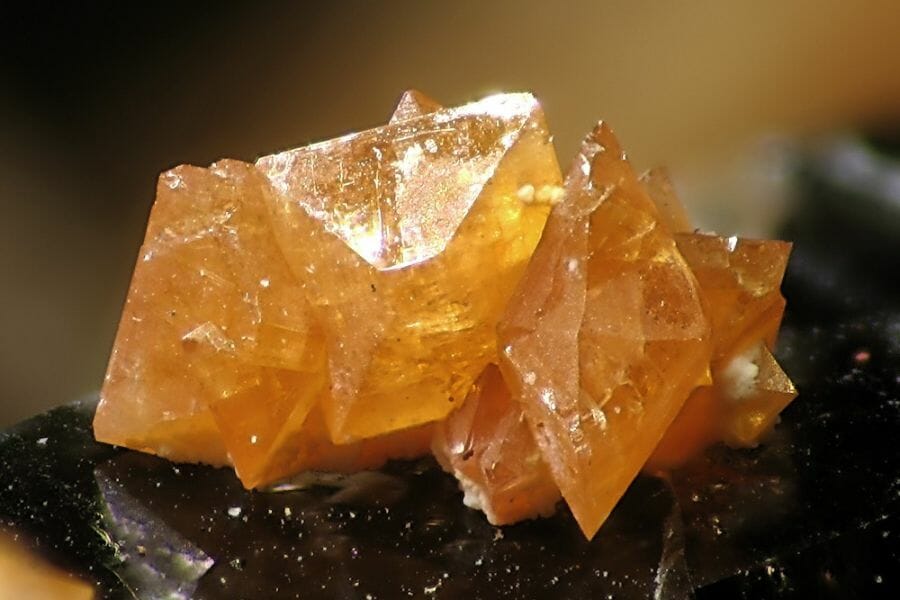
Crystals are like nature’s jewels, sparkling and mesmerizing. They come in all shapes and sizes, from small and delicate to large and powerful. They have been used for centuries to treat ailments, bring good luck, and help people tap into their inner power.
They can be used in rituals or worn as a reminder of the beauty within us all! Each crystal has unique properties, from amethyst to quartz, to help you reach your goals. Explore the world of crystals today; you never know what amazing things await you!
Rare crystals found in New York
- Aquamarine
- Bloodstone
- Bronzite
- Chrysocolla
- Citrine
- Epidote
- Magnesite
- Malachite
- Moonstone
- Sapphire
- Stilbite
- Sunstone
More common crystals found here
- Apatite
- Calcite
- Celestite
- Fluorite
- Galena
- Garnet
- Hematite
- Labradorite
- Muscovite
- Pyrite
- Quartz
- Serpentine
- Tourmaline
- Tremolite
What rough crystals look like
When you’re out looking for crystals on your own it’s important to know what you’re looking for. This is what you need to look out for:
Look for exteriors like this

When you’re out searching for crystals in the wild, it’s essential to keep in mind that what you find won’t look like the polished stones you see in stores. One important tip is to consider what certain crystals look like in their raw, natural form.
Without the shine and smooth finish, crystals might appear rough, with jagged edges or earthy tones masking their true beauty. Understanding this can help you spot potential finds that might otherwise be overlooked.
Examine the crystal structure and shape

Crystals often form in specific geometric patterns that can be key to identifying them. For example, quartz is known for its hexagonal prisms, while halite typically forms cubic shapes.
By recognizing these distinct patterns, you can differentiate between various types of crystals and better understand what you’ve found.
Observe color

Some crystals are known for their distinct hues, like the deep purple of amethyst or the vibrant green of emerald. However, not all crystals will have strong colors; some may be clear or only slightly tinted.
Check the luster

Luster refers to how a crystal’s surface interacts with light. Some crystals might have a shiny, glassy luster, while others may appear metallic or dull. This characteristic can help you determine the type of crystal you’ve found.
However, it’s important to remember that luster isn’t always obvious right away. In some cases, a crystal’s true luster will only become apparent after it’s been cleaned or polished, so keep this in mind as you examine your finds.
Evaluate the transparency

Pay close attention to how much light passes through the crystal. Some crystals are completely clear, allowing light to pass through easily, while others may be opaque and block light entirely.
You might also encounter crystals with translucent edges but opaque centers. These variations in transparency can offer valuable clues about the type of crystal you’ve found, making it easier to identify and appreciate your discovery.
A Quick Request About Collecting
Always Confirm Access and Collection Rules!
Before heading out to any of the locations on our list you need to confirm access requirements and collection rules for both public and private locations directly with the location. We haven’t personally verified every location and the access requirements and collection rules often change without notice.
Many of the locations we mention will not allow collecting but are still great places for those who love to find beautiful rocks and minerals in the wild without keeping them. We also can’t guarantee you will find anything in these locations since they are constantly changing.
Always get updated information directly from the source ahead of time to ensure responsible rockhounding. If you want even more current options it’s always a good idea to contact local rock and mineral clubs and groups
Tips on where to look
Having a better idea of where to look can greatly narrow down your search and increase your chances of finding crystals. By focusing on environments where crystals are likely to be exposed, you can spend less time searching and more time discovering.
Outcrops and Exposed Rock

Rocky outcrops are prime locations for finding crystals and minerals. Search along the edges of outcrops, particularly where erosion has worn away the surrounding soil, revealing the rock underneath.
Pay close attention to any visible cracks, crevices, or small cavities within the outcrop, as these are often where crystals develop and can be extracted with minimal effort.
Stream Beds and Gravel Deposits

Stream beds are dynamic environments where water flow constantly shapes the landscape. Over time, water can erode rocks upstream, breaking them down and carrying mineral fragments, including crystals, downstream.
When searching in these areas, look for spots where the current has slowed, such as bends in the stream or areas behind large rocks, as these are prime locations for deposits.
Quarries and Mines

Quarries and mines are excellent places to search for crystals because they expose deep layers of rock that would otherwise be hidden beneath the surface. These sites often contain a variety of minerals and crystals that have been brought to the surface during excavation.
Pay attention to tailings piles, where waste rock is discarded, as they often contain overlooked or broken crystals. Always prioritize safety when exploring these areas and ensure that you have permission to search.
Road Cuts and Construction Sites

As roads are cut through hillsides or construction projects dig deep foundations, layers of rock and soil that have been undisturbed for millions of years are suddenly exposed.
Look for freshly exposed rock faces, especially where blasting has occurred, as this can create fissures or expose pockets filled with crystals. Be cautious around active construction sites, and always seek permission before exploring.
Mountainous Areas

In mountainous regions, erosion caused by wind, rain, and ice can wear away the softer rock, exposing harder crystals that have formed within. Focus on weathered and broken rock formations.
Look for scree slopes, where loose rock has accumulated at the base of cliffs. Additionally, areas near fault lines or volcanic vents are particularly promising, as they often have a higher concentration of minerals.
DON'T MISS OUT ON ANY GREAT FINDS!
While you're out searching for Crystals you're going to find A LOT of other interesting rocks and minerals along the way. The last thing you want to do is toss out something really interesting or valuable. It can be easy to misidentify things without a little guidance.
We've put together a fantastic field guide that makes identifying 140 of the most interesting and valuable rocks and minerals you will find REALLY EASY. It's simple to use, really durable, and will allow you to identify just about any rock and mineral you come across. Make sure you bring it along on your hunt!
New York Crystal Mining Laws And Regulations
Anyone wishing to crystal hunting must first obtain a New York Department of Environmental Conservation permit. Once registered, miners must follow certain guidelines regarding where they can search for crystals and how much they can collect.
For example, miners can collect no more than five pounds of quartz crystal daily and may not use mechanical devices or explosives when collecting specimens.
Furthermore, all specimens must be left in their natural state; no cutting or polishing is allowed. Collectors should be aware that there are certain areas in New York State where crystal mining is prohibited altogether due to its sensitive nature; these areas should be avoided at all costs.
- The extensive local experience and understanding of our team
- Input from multiple local crystal hunters and crystal collecting groups
- The accessibility of the crystal mining locations
- Safety and potential hazards when collecting
- Private and public locations
- A desire to include locations for both experienced crystal hunters and those who are just starting out
Using these weights we think we’ve put together the best list out there for those who love finding new crystals for our collections!
The Best Locations For Crystal Mining in New York

Check out these places if you can only visit a few sites. We have the most success in these areas and believe you will too.
Always Confirm Access and Collection Rules!
Before heading out to any of the locations on our list you need to confirm access requirements and collection rules for both public and private locations directly with the location. We haven’t personally verified every location and the access requirements and collection rules often change without notice.
Many of the locations we mention will not allow collecting but are still great places for those who love to find beautiful rocks and minerals in the wild without keeping them. We also can’t guarantee you will find anything in these locations since they are constantly changing.
Always get updated information directly from the source ahead of time to ensure responsible rockhounding. If you want even more current options it’s always a good idea to contact local rock and mineral clubs and groups
Balmat-Edwards Zinc Deposit

St. Lawrence County, NY
If you’re looking for a good area in the state to find some stunning crystals, you might want to peek at the Balmat-Edwards Zinc Deposit. It’s easy to see why crystal hunters have long regarded this historical location as one of their favorites.
You can also include this spot in your list of where you can mine gems in New York.
The area has been known for its mineral deposits since the mid-1800s, and it’s located along the western shores of Lake Ontario. Geologically speaking, it’s made up of a mix of metamorphic and sedimentary rocks rich in sulfide minerals like zinc, lead, and copper.
It’s a great spot for crystal hunting because these minerals often contain beautiful crystals that can be collected by hand. Plenty of other minerals are found in the area, too – quartz, garnet, hematite – so you’ll never get bored! And if you’re feeling adventurous, there are caves and tunnels to explore with amazing crystal formations.
Where we found crystals at the Balmat-Edwards Zinc Deposit
We have collected various crystals, such as apatite, calcite, celestite, chalcopyrite, galena, garnet, hematite, pyrite, quartz, rhodonite, serpentine, tourmaline, in the whole area of the Balmat-Edwards Zinc Deposit.
DON'T MISS OUT ON ANY GREAT FINDS!
While you're out searching for Crystals you're going to find A LOT of other interesting rocks and minerals along the way. The last thing you want to do is toss out something really interesting or valuable. It can be easy to misidentify things without a little guidance.
We've put together a fantastic field guide that makes identifying 140 of the most interesting and valuable rocks and minerals you will find REALLY EASY. It's simple to use, really durable, and will allow you to identify just about any rock and mineral you come across. Make sure you bring it along on your hunt!
Brant Lake
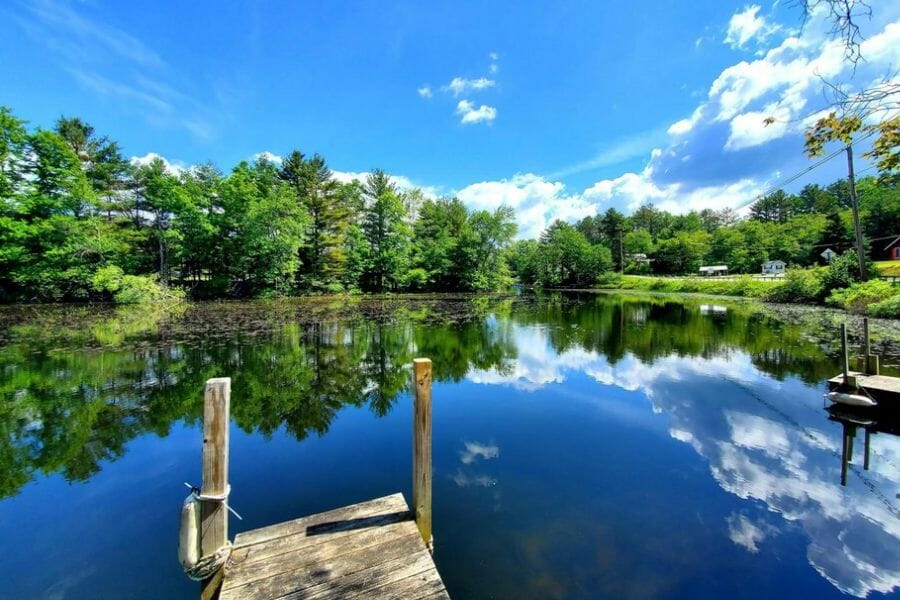
Warren County, NY
Brant Lake in New York is a great place to go if you’re looking for crystals. Located in the Adirondack Mountains, it has been a popular destination for crystal hunters since the early 1900s.
It’s known for its quartz and calcite deposits, easily accessible due to the lake’s shallow water. The terrain around Brant Lake is mostly hilly, with some flatland near the lake itself, so it’s easy to find a spot to hunt for crystals.
The lake is fed by several small streams that run through the area and provide plenty of opportunities for wading and searching.
The area also offers plenty of outdoor activities, such as camping and crystal hunting, making it an ideal spot to spend your vacation if you want to find crystals while enjoying outdoor fun.
With its picturesque views of the Adirondack Mountains and its abundance of crystal deposits, Brant Lake is a great place to visit if you want to find some unique treasures.
Where we found crystals at Brant Lake
There are apatite, calcite, muscovite, pyrite, and tourmaline crystals found south of the shore, in the roadcuts through the pegmatites of Brant Lake.
Diamond Acres Mine

1706 Stone Arabia Rd, Fonda, NY 12068
Diamond Acres Mine in New York has been a popular tourist destination for crystal-seekers since the early 1900s. Located in the Catskill Mountains, it’s known for its varied terrain and abundance of quartz crystals.
The mine lies on an ancient riverbed filled with millions of years of sedimentary deposits. The mix of rocks and minerals creates an ideal environment for crystal growth, making it a great spot for finding quartz, calcite, and amethyst.
You can explore the mine’s many tunnels and caverns or purchase mining equipment to dig their crystals from the ground. Many experienced miners recommend going with a guide to get the full experience.
With its rich history, stunning scenery, and ample opportunities to find crystals, Diamond Acres Mine is a must-visit destination for anyone looking to get their hands on some gorgeous crystals!
Where we found crystals at Diamond Acres Mine
Quartz crystals are primarily found at Diamond Acres Mine in the Fonda area. We’ve made a thorough article on crystals value for rockhounds who want to learn more about them.
Lake Harris

291 Campsite Rd, Newcomb, NY 12852
Lake Harris is a great place to go if you’re looking for crystals in the state. Located in the Adirondack Mountains, Lake Harris is known for its crystal-filled beaches and its rich history.
The lake was formed over 10,000 years ago by melting glaciers, creating a large body of water surrounded by mountains and hills.
It’s also one of the deepest lakes in the area, reaching depths of over 40 feet. Its crystal-filled beaches are made up of quartz, and other minerals eroded from the surrounding rocky terrain.
You can find crystals in various shapes and sizes along the shoreline, such as apatites, tourmalines, quartz, and more.
For those looking to explore further into the lake’s depths, there are plenty of opportunities to find even more precious stones. With its breathtaking views and abundance of crystal-filled beaches, Lake Harris is definitely worth a visit if you’re looking to add some sparkle to your life!
Where we found crystals at Lake Harris
Apatite, muscovite, pyrite, quartz, tourmaline, and tremolite crystals are abundant in the area outcrops of Lake Harris.
Tilly Foster Mine

Putnam County, NY
Tilly Foster Mine is located in Brewster, New York, and it’s been around since the 1700s. The mine is best known for its abundance of quartz crystals, which are found in various colors, such as clear, pink, and purple.
The mine is also home to iron ore and magnetite deposits. Geologically speaking, the area is rich in sedimentary rocks like limestone and shale due to its location near the Hudson River.
There’s also plenty of history here – the mine was once used as a source of iron ore during the Revolutionary War! Plus, you can take home some souvenirs or get your hands on unique jewelry made from quartz stones within the mine walls.
So if you’re looking for an adventure, Tilly Foster Mine is the perfect destination.
Where we found crystals at Tilly Foster Mine
We had the best luck locating different types of crystals, like apatite, bronzite, calcite, chalcopyrite, chrysocolla, fluorite, garnet, hematite, magnesite, malachite, muscovite, opal, pyrite, quartz, serpentine, tourmaline, and tremolite around all the areas of Tilly Foster Mine.
Our Other Favorite Places For Crystal Hunting

After giving our top five sites for finding crystals, we wanted to share many more options. Because our state is vast and has a diverse geology, there are more fantastic places to go crystal hunting, including where you can find geodes in New York. Other locations to visit are as follows:
Where you can find crystals for free in New York
Let’s begin by discussing a few areas where you may hunt for no price. Even though many of the most incredible locations require a fee, certain places are still free to visit.
| County | Location |
| Cayuga | Old pits in the Auburn area for fluorite |
| Clinton | Buttermilk Falls at Keeseville for serpentine |
| Erie | The Fogelsanger Quarry at Buffalo for calcite |
| Erie | Area deposits of Eighteen Mile Creek for pyrite |
| Essex | The gravel beds and bars of Opalescent River and area gravels and outcrops of Cascade Lakes for labradorite |
| Jefferson | In the area quarries of Muscalonge Lake for fluorite |
| Madison | In the area quarries of Cazenovia and Chittenango Falls for celestite |
| Niagara | In the area limestone quarries of Lockport for fluorite |
| Ontario | Candice Lake and Honeoye Lake for labradorite |
| Orange | Along the Hudson River area for bloodstone and jasper |
| Richmond | At the southwest tip of Staten Island in the Androvette Clay Pits for serpentine |
| Schoharie | At the area exposures of the Roundout Waterline for celestite |
| St. Lawrence | At Rylestone Quarry, outcrops of Oswegatchie River for calcites, fluorites, and serpentines |
| St. Lawrence | The Hobby Quarry at Bedford for citrine crystals |
Other great places to dig for crystals
Here are some additional locations where you can look for crystals if you want to pay. The price will vary depending on the season, and sometimes it may be free. You should get in touch with them before visiting the areas.
| County | Location |
| Clinton | Palmer Hiss Mine and Finch ore bed for fluorites |
| Clinton | In the dumps of Arnold Mine for jasper |
| Essex | Area mines of Mt. Bigelow for garnets |
| Essex | Fisher Hill Mine for sunstone |
| Essex | Old mines of Oven Mountain for garnet |
| Montgomery | Crystal Grove campsite for quartz |
| Montgomery | Sprakers at Fonda for quartz |
| Orange | The Phoenix Mine at Otisville for galena |
| St. Lawrence | Gouverneur Talc Mine, Arnold Open Pit Mine, Zinc Mine, Loomis Talc Mine for apatites and tremolites |
| Warren | Go 5 miles up Gore Mountain to shop at Barton Mines for garnet |
Identifying crystals can be a bit challenging, but don’t worry! Our comprehensive guides will help you distinguish between the most commonly confused crystals, making it a breeze to tell them apart.
Always Confirm Access and Collection Rules!
Before heading out to any of the locations on our list you need to confirm access requirements and collection rules for both public and private locations directly with the location. We haven’t personally verified every location and the access requirements and collection rules often change without notice.
Many of the locations we mention will not allow collecting but are still great places for those who love to find beautiful rocks and minerals in the wild without keeping them. We also can’t guarantee you will find anything in these locations since they are constantly changing.
Always get updated information directly from the source ahead of time to ensure responsible rockhounding. If you want even more current options it’s always a good idea to contact local rock and mineral clubs and groups
The Best Crystal Shops In New York

Because the state offers a large variety of crystals spread out across such a vast area, many of us love making small purchases to complete our collections. If you’re seeking unique and stunning items, these are the best crystal shops we’ve found.
- Astro Gallery of Gems – 417 5th Ave, New York, NY 10016, United States
- Astro West Fine Minerals – 102 W 79th St, New York, NY 10024, United States
- Crystals Garden NYC – 247 E 10th St, New York, NY 10009, United States
- Emerald Gem Exchange – 145 Front St, Brooklyn, NY 11201, United States
- June’s House of Crystals – 276 Grand St, Brooklyn, NY 11211, United States
- Mardani Fine Minerals – 766 Madison Ave, New York, NY 10065, United States
- Namaste Bookshop – 2 W 14th St, New York, NY 10011, United States
- Rock Star Crystals – 146 W 26th St, New York, NY 10001, United States
- Ruby’s House of Crystals – 119 Columbia St, Brooklyn, NY 11231, United States
- Stick Stone & Bone – 113 Christopher St, New York, NY 10014, United States
Additional places to find crystals in nearby states
If you’ve already tried all of our recommendations above or are planning a trip out of the state, you should check out our guides for neighboring states:
- Crystals in Connecticut
- Crystals in Massachusetts
- Crystals in New Jersey
- Crystals in Pennsylvania
- Crystals in Vermont
If you have any recommendations we haven’t covered, please leave them in the comments below!

